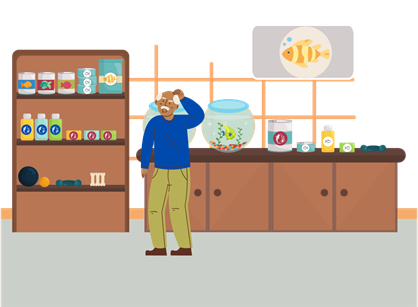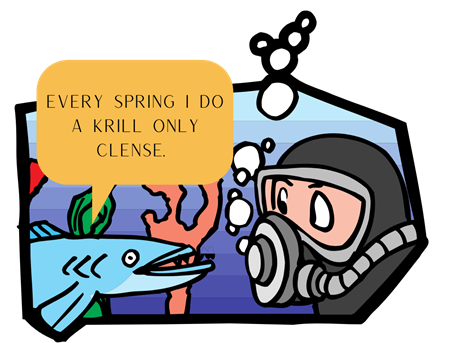
Feeding your Fish

Have you ever gone to your local aquarium shop and looked at all the different types of food available to feed your fish and ended up confused and scratching your head?
Over the next series of nutrition blogs we would like to give you some insights from a veterinary perspective of the appropriate types of food to feed your aquarium fish. We will firstly discuss the things to consider when you are deciding whether a food is appropriate to feed your fish species. Then we’ll discuss the form of feed, whether it should be a dry food, a wet food or a cultured food. Lastly, we’ll touch on how you can mix and match all of these different diets to suit either an individual fish in a tank or a really nice tropical fish display.
So let’s start at the beginning. Naturally, the types of food or diet that a fish will eat is determined by its biology. Fish, like other animals will either be primarily carnivorous, herbivorous or somewhere in the middle, omnivorous. Fish in the wild self-select the types of food that they’ll eat, not surprisingly given Mother Nature knows best!
Feed availability and type is determined by the environment, and as we know, fish have evolved in a myriad of different habitats. Therefore, it is important to understand that fish nutrition is intimately linked and reflective of their environment. As fish keepers, we are the soul determinant as to what sort of food is made available to our fish. They can’t swim to find and select the food that they need and so we need to provide a selection of food for these fish that is appropriate for their growth, survival and prosperity to a ripe old age.


Many of the dry flake or pelleted products that are available have been manufactured from a variety of constituents, depending on the feed formulation. The art and the science of food manufacturing allows manufacturers to produce appropriate diets for specific fish. Provided we have an understanding of the types of feed items that the fish would naturally select, or in other words the requirements for their diet, we can mimic a good diet. The problem with many of our aquarium fish or ornamental fish is that we don’t really know or even understand their natural dietary requirements. The way to get around this when diets are manufactured is to rely upon a generalised understanding of the types of foods that a general group of fish, that are closely related, might consume in the wild. Occasionally we are lucky enough to have access to scientific research on specific dietary requirements for some breed of fish. Through this research diets for similar species are formulated, on the assumption they have the same requirements.
One of the ways that manufacturers formulate diets is on the basis of a ‘least cost ration’.
This means they have incorporated all the essential nutrients that are thought to meet the requirements of a fish type (growth, maintenance, reproduction etc.) at the least cost price.
For example there might be knowledge on what protein, carbohydrate, vitamins, minerals or micronutrients level are required by a specific fish species, so the diet is put together such that it costs the least amount of money to produce a gram of feed whilst meeting the requirements of that fish. It’s a little bit of eye of newt and wing of bat, but at the least cost.
Now whilst this can work it assumes a number of things. Firstly, it makes the assumption that we have the appropriate knowledge about the composition and interaction of the individual nutrient components within the diet. Secondly, an assumption is made that all constituents are appropriate for fish consumption, which is NOT the case. A general example of this is inclusions of flours from various terrestrially grown grains. Grain flour is certainly not a component that fish are naturally exposed to, in fact, it is very unlikely for any fish to have sought out the kernels of grass seeds etc in their natural diets.

Flour does serve as a source of carbohydrate to fish but it is mainly included as a binding agent allowing these diets to stick together and keep their form, such as a pellet for example. Many fish don’t digest these components very well and in some cases plant carbohydrates and proteins actually add anti-nutritional factors to the diets. So we here at For Fish think that there’s possibly better ways of formulating diets, for example, performing research and observations on what fish are selecting in their natural environments. We believe this will allow for diets to be formulated on an appropriate constituent and nutritive basis rather than a ‘least cost ration’ one.

It is known that in natural environments the fish we keep as ornamental fish will have a diet that includes high proportions of plant material, insects and other arthropods. These components are made available in forms of algae, phytoplankton, zoo plankton and aquatic or terrestrial plants and insects. Carnivorous fish will gain access to these components by ingesting other fish that consume these constituents. Herbivorous fish will naturally select more of the plant material and algae’s as their biology provides them the ability to process these types of complex carbohydrate rich foods to supply their nutrients. Omnivorous fish have a wide range of components to select from which changes based on seasonality. As the environment changes through the seasons of the year so does the available food resources for selection. Biology has it that usually when there is an abundance of appropriate foods that will coincide with seasons of breeding or reproduction and growth.
So what we are trying to do at For Fish is to select diets based upon good quality constituents that will mimic the types of feed constituents that would be available to fish in the natural aquatic environment. We will still be including some terrestrial based constituents such as flours from grains for feed binding and as a source of carbohydrates but we aim to minimise their inclusion to the best of our ability.
Let’s go back to the dilemma of food selection for your fish. We notice many posts on this topic on social media and chatrooms where hobbyist and fish keepers are looking for advice.
With the vast amounts of advice and opinions on this topic the reality becomes that most fish keepers utilise commercially manufactured dry feeds as the primary source of nutrition for their fish. Devoted aquarists and experienced hobbyists keeping a range of fish species and that have an enhanced understanding of keeping fish tend to seek higher quality diets by using a mix of selected diets for their fish to maintain health. This may include manufactured dry products, home manufactured wet products as well as home-grown live products.

Our general rule of thumb for all fish is that, providing a variety of food is best. Not only does this provide a degree of variety and selection, but it also enriches the environment for the fish. So how do you apply that basic philosophy to feeding your fish? We would advise that you feed your fish appropriate flake or pellet food as a basic component following the manufacturers recommendations usually found on the container. Additionally, we would combine commercial or home-made frozen products fed weekly or fortnightly. You can buy a range of frozen products from aquarium shops that have a mix or even specific food like krill of brine shrimp. The wet components in the diet will help avoid the occasional occurrence of constipation in your fish, that is usually seen as long intact faecal strands attached your fishes cloaca. Using a dry food only diet is a bit like eating bread 24/7 for yourselves which ends with constipation. The addition of wet foods allows for the addition of fresh components within the diet as well as aid in the maintenance of a natural gut environment for your fish.
Live foods serve as a really good supplement for fish particularly if your intention is to breed them. There are some seasonal variation in nutritive requirements that allow live feed to aid in conditioning fish, making them much more likely to breed.
Storage time and condition of food is also very important. We would advise that if you are buying your fish foods or dry foods that you vary the types of manufacturer’s product each time you buy them as they are not all the same.


A rule of thumb we recommend all opened fish food products should be stored in the fridge at 4oC for a maximum of six months and then discarded. Refrigeration allows the maximisation of micronutrient survival and antioxidant survival in the diets. Frozen food products should be always kept frozen and again if it’s six months or older than when you purchased or opened it, we would advise that you discard it and purchase more. Take notice of the manufacturing date on your food as you purchase it and look for the longest date food on the shelf.
Many of the fish foods that are sold in Australia are imported from overseas. There are a small number of products that are manufactured in the country and so they so they will be less likely to be short dated when you buy them due to the sheer distances and transport involved. Remember, the fresher the diet the better it is for the fish that you feed. It’s important that we realise this for the health of our fish because whilst most of the problems we see in fish are due to water quality issues, the next most common one, particularly for the long term chronic issues of fish health, arise from poor diets. If you maximise the quality of the foods that you feed your fish you will help them to live long and active lives. Again this shouldn’t surprise you because it’s exactly the same with us humans.
In future blogs on nutrition we will expand on all aspects of this general nutritive discussion. We hope that the storage and selection tips given to you here has provided you more understanding on the importance of fish nutrition in fish health, as well as encourage you to provide a variety of foods for your fish and to store your fish food appropriately.
Collaborate with US

Sponsorships
Sponsored content that’s sustainable, relevant and evidence based.

Your Tips
Tell us your tips and tricks in improving your animal husbandry techniques.

Your Fish
Send us your best snaps of your fish and tell us what you are most proud of in your system.
